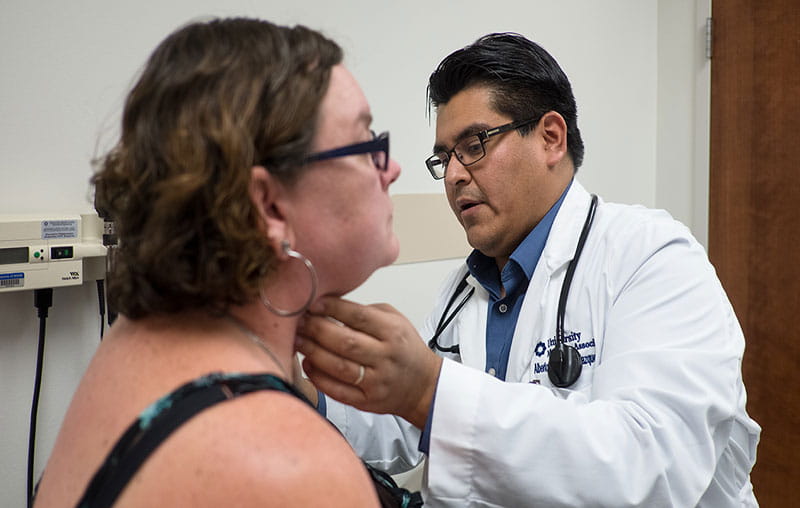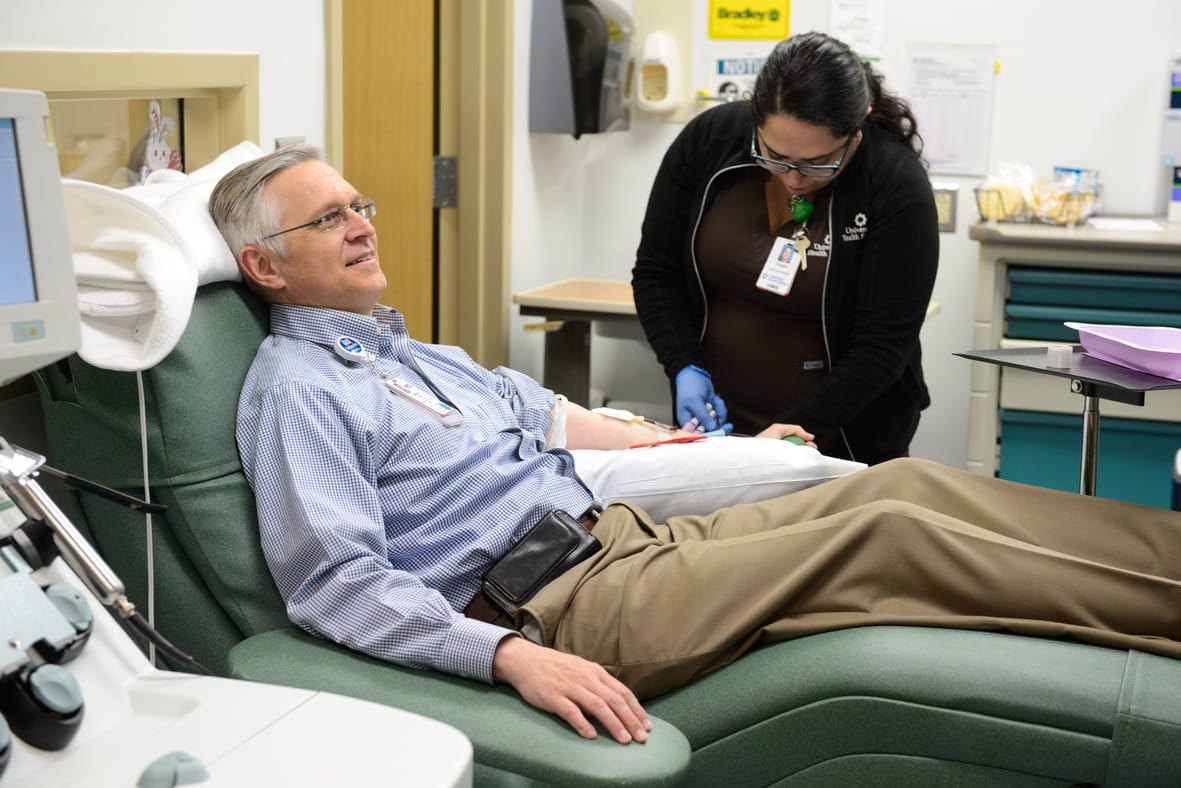For expecting families, the goal is always to have a healthy and safe pregnancy. Still, sometimes complications arise that may classify a pregnancy as high-risk.
You are considered “high-risk” if your obstetric provider has identified factors that could increase the chance of complications during or after your pregnancy.
One those complications is called placenta accreta.
Dr. Patrick S. Ramsey, a maternal-fetal specialist at University Health, answers common questions about placenta accreta and what expecting mothers should know if they are diagnosed with it.
You can also watch our illustrated video “What is placenta accreta?” on YouTube.
What is placenta accreta?
After your baby is born, the placenta detaches from the uterine wall and gets delivered. Placenta accreta happens when the placenta is attached too deeply to the uterus.
During delivery, the abnormally attached placenta does not completely come out, which can lead to life-threatening bleeding.
Early recognition and delivery planning is critical for women with this pregnancy complication to prevent serious harm to mother and baby.
Who is at risk for placenta accreta?
You’re at a higher risk for placenta accreta if you:
- Have had previous surgery on the uterus, including a cesarean section
- Have been pregnant before
- Are 35 or older
- Have a pregnancy from in vitro fertilization
- Have abnormal placenta position
- Have placenta previa noted on an ultrasound
- Have a history of endometrial ablation
- Have had prior uterine curettage (dilation and curettage or dilation and evacuation)
- Have a history of Asherman syndrome
- Have had a uterine myomectomy
Is placenta accreta common?
Cases of placenta accreta are increasing in the United States. In 2016, it was estimated there was a case for 1 in every 271 pregnancies. This is significantly higher compared to the 1960s, when the incidence was around 1 in 3000 deliveries (0.03%).
The significant increase in this pregnancy complication likely has resulted from several factors, including:
- Increased use of cesarean delivery
- Higher age of pregnancy
- Increased use of in vitro fertilization
What are the symptoms of placenta accreta?
Often, there are no signs or symptoms of placenta accreta. Bright red bleeding during the third trimester could mean that something is wrong with the placenta.
How is placenta accreta diagnosed?
Placenta accreta is best diagnosed by an ultrasound performed by a provider with experience in evaluating for placenta accreta. These providers are usually maternal-fetal medicine specialists who have spent three additional years of training specifically to identify abnormalities of the placenta, fetus and uterus.
There are certain ultrasound findings which are looked for which can raise concern for placenta accreta. These include:
- Large vascular lakes in the placenta
- Thin uterine wall
- Placental bulge in the bladder
- Large blood vessels connecting the placenta to the bladder
In some cases where placenta accreta is suspected, an MRI may be ordered as an additional assessment.
Are there different types of placenta accreta?
The different types of placenta accreta are related to how deeply the placenta is attached to the uterus.
- Placenta accreta happens when the placenta attaches into the muscular wall of the uterus.
- Placenta increta occurs when the placenta goes partially through the uterine wall.
- Placenta percreta happens when the placenta goes through the outer wall of the uterus and attaches to outside organs.
What is the treatment for placenta accreta?
If the placenta accreta is not treated properly, it can result in severe health problems and even death for baby, mother or both.
In some cases, early delivery or hysterectomy are necessary to reduce complications.
Is placenta accreta preventable?
Yes and no. The only potential way to prevent placenta accreta is to avoid having the initial cesarean delivery or uterine surgery, as these are the strongest risk factors. There are no other interventions known at this time to prevent placenta accreta.
Do you have to deliver early?
Yes. If you are suspected or known to have a placenta accreta, delivery between 34- and 36-weeks’ gestation is recommended. This is to avoid going into labor, which could result in serious, life-threatening bleeding.
In general, women who have placenta percreta will deliver around 34 weeks' gestation. Other types of placenta accreta delivery may be at 35-36 weeks.
In some cases, if there are recurrent bleeding episodes, preterm labor contractions or high concern for invasion of the placenta outside of the uterus, delivery earlier than 34 weeks is recommended.
Is bed rest required?
Not necessarily. Bed rest has not been shown to be beneficial for the care for women with most pregnancy complications. If you have recurrent episodes of bleeding or recurrent preterm contractions, sometimes bed rest may be recommended.
In cases where a placenta accreta is associated with a placenta previa, pelvic rest (no vaginal sex, nothing in vagina) is strongly recommended to avoid disruption of the placenta, which could cause life-threatening bleeding.
Will placenta accreta affect my child’s development during pregnancy?
No. The placenta accreta itself will not cause any concerns for your baby’s development during pregnancy. Even though early delivery is recommended for women with placenta previa, delivery usually occurs at a gestational age range where the risk for the baby to have major problems or developmental issues is very low.
Can I get pregnant again if I’ve had placenta accreta?
In most cases where there is clear evidence of placenta accreta, a hysterectomy is needed to minimize blood loss and prevent complications for you and your baby. If you have a hysterectomy, you would be unable to have any additional pregnancies.
In cases where the diagnosis is uncertain, your care team will prepare completely for your delivery and will assess at the time your baby delivers to see if there is evidence of placenta accreta–and if not, they may not need to perform a hysterectomy. In this case, you would be able to carry future children but may be at higher risk for placenta accreta in your next pregnancy.
Women’s & Children’s Hospital is a Level IV Maternal Center
Take an online tour of our Women’s & Children’s Hospital, a Level IV maternal center, which is the highest level of certification.
Evidence suggests that the best outcomes for patients with placenta accreta is when the woman delivers at a high-level maternal center that has an established team with experience in the evaluation, diagnosis, pre-operative planning and management of placenta accreta.
Our Women’s & Children’s Hospital can care for moms with high-risk pregnancies and their babies. You can trust our team to provide poised, expert care for the most complex cases.
Placenta accreta team at University Health
Our placenta accreta team at University Health has a comprehensive team of providers. We have the most comprehensive range of specialists and subspecialists of any maternal care center in South Texas.
In addition, all of our providers are under one roof, available 24/7 for any urgent delivery needs and provide the highest level of maternal care in the region.
Knowing your risk factors before pregnancy is key to a healthy journey.
Take our Prenatal Health Risk Assessment to better understand your risk for a high-risk pregnancy, so you can plan for a safe pregnancy and healthy baby.





